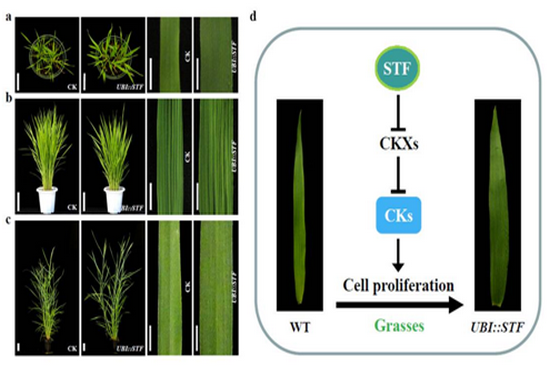Recently, a new progress in the improvement of biomass yield in grasses was reported by researchers from Biotechnology Research Institute of CAAS. This work was online published in the latest issue of PLoS Genetics
Lignocellulosic biomass can be a significant source of renewable and sustainable clean energy with continued improvement in biomass yield and bioconversion strategies. In higher plants, the leaf blade is the central energy convertor where solar energy and CO2 are assimilated to make the building blocks for biomass production. Here the researchers report that introducing the leaf blade development regulator STENOFOLIA (STF), a WOX family transcription factor, into switchgrass, Brachypodium and rice significantly improves both biomass yield and saccharification efficiency. The authors found that STF overexpressing switchgrass plants produced approximately 2-fold more dry biomass and release approximately 1.8-fold more soluble sugars without pretreatment compared to controls. The biomass increase in all the three species was attributed mainly to increased leaf width and stem thickness, which appeared to be caused by enhanced cell proliferation. STF directly binds to multiple regions in the promoters of several cytokinin oxidase/dehydrogenase (CKX) genes in vitro and in vivo and represses their expression. This repression was accompanied by a significant increase in active cytokinin content in leaves, suggesting that STF promotes biomass productivity and sugar release by increasing active cytokinins through direct repression of cytokinin degrading CKXs. This study provides a new tool for improving two important biomass feedstock traits, yield quantity and quality, in bioenergy crops, and uncovers a novel mechanism in the function of STF and repressive WOX genes that are master regulators of several plant developmental programs.

Dr. Hui Wang, Dr. Lifang Niu and Dr. Chunxiang Fu are the co-first author of this paper, Dr. Hao Lin and Prof. Million Tadege are the corresponding authors. This work was supported by grants from Ministry of Science and Technology of the People’s Republic of China, National Natural Science Foundation of China and Chinese Academy of Agricultural Sciences.
Link: http://journals.plos.org/plosgenetics/article?id=10.1371/journal.pgen.1006649
|